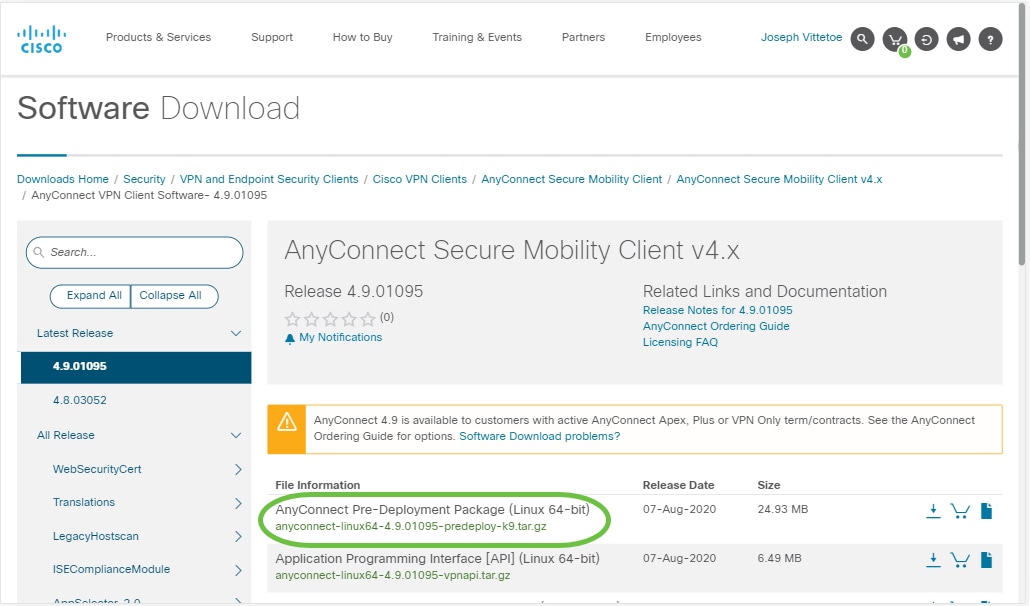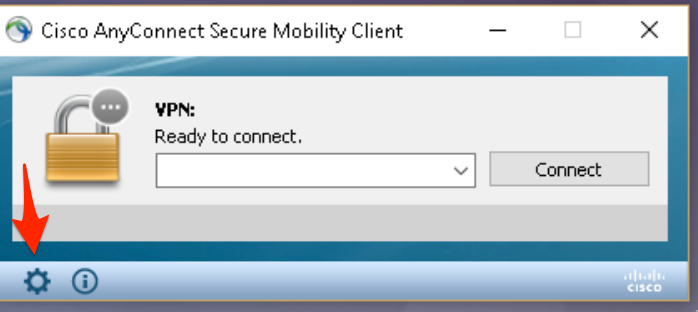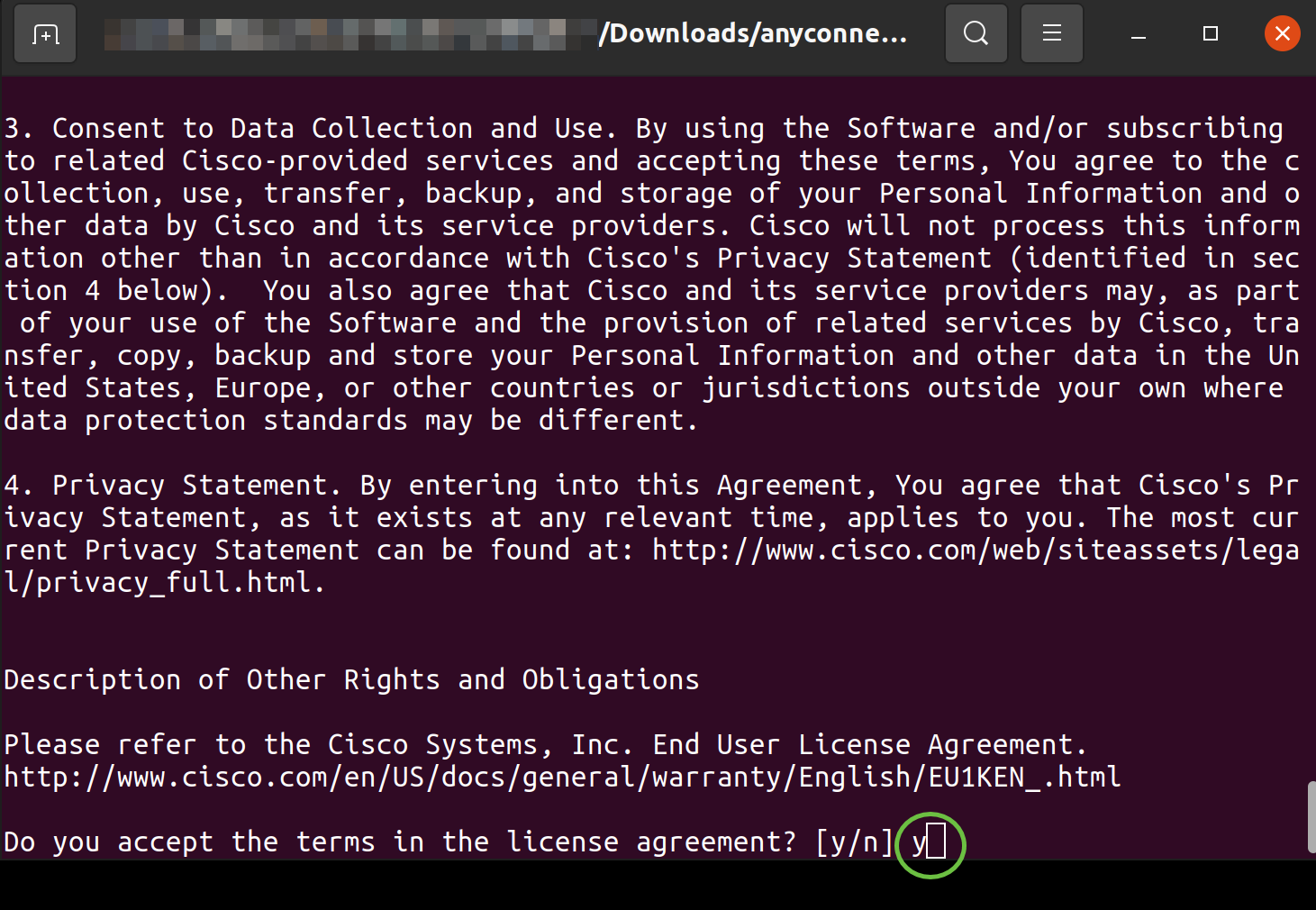Download Cisco AnyConnect Secure Mobility Client Note Cisco AnyConnect Secure Mobility Client is only available to Cisco customers with active AnyConnect Apex, AnyConnect Plus or AnyConnect VPN Only subscriptions. Therefore, Navigate to the Cisco AnyConnect releases page and choose the version to download. AnyConnect Pre-Deployment Package (Windows 10 ARM64) - includes individual MSI files Login and Service Contract Required anyconnect-win-arm64-4.9.05042-predeploy-k9.zip 17-Dec-2020.
- Cisco Anyconnect Client Download Linux Os
- Cisco Anyconnect Client Download Linux 64-bit
- Cisco Anyconnect Download
Virtual Private Network (VPN) is a remote access technology that creates a private encrypted connection over the Internet between a single host and Stanford's private network, SUNet.
Stanford's VPN allows you to connect to Stanford's network as if you were on campus, making access to restricted services possible. There are two types of VPN available:
- Default Stanford (split-tunnel) allows access to anything at stanford.edu via the VPN connection but non-Stanford traffic flows normally on an unencrypted internet connection.
- Full Traffic (non-split-tunnel) encrypts all internet traffic from your computer but may inadvertently block you from using resources on your local network, such as a networked printer at home.
Features
- When using VPN, your off-campus computer is dynamically assigned a Stanford IP address to connect back to Stanford's network.
- A Stanford IP address allows you access to Stanford's computing resources and certain campus services (e.g., departmental file and print servers).
Designed for
Faculty, staff, and students
Requirements
- An active SUNet ID
- Windows 8 SP1 and later
- Mac OS X 10.9 and later*
- iOS 10 or later
- Android OS 6.0 or later
*Note for Mac High Sierra (10.13): When you log in to the Cisco AnyConnect VPN, you may be prompted to upgrade to a new version of software. If you choose to upgrade, you'll see a System Extension Blocked alert directing you to go to System Preferences > Security & Privacy to allow the extension. The approval field is only present in the Security & Privacy preferences pane for 30 minutes after the alert. If the extension is not approved with in 30 minutes the software will not function correctly.
Data security
Get started

Select your operating system to see the VPN configuration instructions for your device:
Learn more
Many commonly used Stanford applications and services are available directly from the Internet without the use of VPN. While VPN does encrypt your data in transit, nearly all of the web-based applications you access already default to secure https communication, and are therefore already encrypted.
Examples of commonly used Stanford services which do not require VPN:
- Office 365
- Zoom
- WebEx
- Axess
- Oracle Financials
- Cisco Jabber
- Slack
- Google Drive
- G Suite
University IT (UIT) recommends that you donot enable your VPN connection unless the server or application that you are trying to access requires a VPN connection. Using VPN adds unnecessary additional overhead, which may degrade the user experience while connected, especially for video conferencing, streaming services, or applications.
Stock picker forklift. The SP Series 4-wheel platform stock picker is a heavy-duty stand-up lift truck used in areas where loads are bulky or extra long, such as furniture or department store warehouses.
Many secure servers within the Stanford University network do require the use of VPN. There is no published list of these servers, but it is easy to quickly determine whether the server/system you are attempting to connect to requires VPN with this simple test: try performing daily duties without the VPN enabled. If you cannot access a service, enable the VPN and try again.
If you do require a VPN connection, UIT recommends that you use the split-tunnel profile rather than full-tunnel. The split-tunnel profile enables the Internet-bound traffic to flow directly outbound via your home ISP, without first going to the Stanford VPN, and then route to the Internet. This also ensures better performance overall. Please remember that when using the full-tunnel profile, all traffic from your system routes first through the Stanford VPN and then out to the Internet.
Stanford University Libraries (SUL) updated the method by which authorized community members access restricted journals from off-campus.
Rather than using Stanford's VPN (Virtual Private Network), SUL wants community members to use its EZProxy service: http://library.stanford.edu/using/connect-campus/ezproxy-alternative-campus-access
See also
- Instructions for using Remote Desktop to work remotely
- Work Anywhere website for more resources for telecommuting and remote work
William Cash and Keonwook Kang
|
Updates
4/28/09 - This guide has been around in different forms for nearly two years and has generated a good deal of interest. The basic steps are still exactly the same, but many of the compilation errors listed in the subsections have been resolved in newer versions of the Cisco VPN client (v4.8.02.0030) and Linux kernel (2.6.28). I'm still actively updating this site for my own sake, so please contact me (William Cash) with any mistakes or suggestions.
4/29/09 - Added a section on vpnc in Ubuntu, because I now feel that it's integrated into the OS well-enough to be superior to the Cisco VPN client.
Introduction
Cisco VPN is required to connect to many of Stanford's computer resources because of some past security lapses. Unlike the Windows and Mac OS clients, Cisco's Linux VPN requires use of the terminal and comparatively little documentation from the company. This guide will show you how to install and use the Linux client. In addition, it addresses some of the most common problems encountered during this problem.
As an alternative to using the Cisco VPN client, vpnc is an open-source program available on many *NIX systems that is compatible with Cisco VPNs. A general guide for vpnc is not included here. However, instructions for using it with Ubuntu's Network Manager are discussed at the end of this document. This is a more elegant and useful way to connect to Cisco VPNs, and I encourage Ubuntu users to try this before they install the Cisco VPN client.
Installing the VPN client
Note: most of the following steps require superuser access.
- Download the v4.8 VPN client from http://vpn.stanford.edu.
- Extract the downloaded file.
- Install the VPN client
- Answer the following questions during the installation (the defaults should be fine)
- Note that you need to reinstall the VPN client whenever your kernel is upgraded. Before reinstalling it, first run:
- to clean files and directories previously installed.
If you're receiving errors during installation
Most common error
With the newer Linux kernels that are incompatible with the Cisco VPN you may receive an errors similiar to these:
This is a fairly well known problem with numerous websites and forum postings on the topic. The website http://projects.tuxx-home.at has been releasing patches for the installation files of the Cisco VPN client for all the latest Linux kernels.
Instead of using the VPN client provided by Stanford, download the latest one from there (currently v4.8.02.0030) and the patch file for the linux kernel you are running. Update: Stanford has finally decided to upgrade its download to v4.8.02.0030 , as well. If you aren't sure which you have run:
Assuming you've already performed steps 1-2 of installation procedure for the new client, you will now place your patch file in the vpnclient directory and patch the installation:
Then follow steps 3 and 4 as before.
Description The Citrix Workspace app allows for secure, unified access to all of your SaaS apps, web apps, virtual apps, files, and desktops. If your company uses Citrix, simply login with your company credentials to access all of the resources you need to be productive from anywhere. The Citrix Workspace environment is faster, always available, stable, and extremely user friendly. And the best thing about it is that users say they don’t even notice it because it always works. When the amount of disk space is low in /var directory of the appliance, you might not be able to sign in to the Citrix GUI. In this scenario, you can remove the old log files to create free space in /var directory. Citrix workspace for windows 10. Citrix Workspace app is the easy-to-install client software that provides seamless, secure access to everything you need to get work done. With this free download, you easily and securely get instant access to all applications, desktops and data from any device, including smartphones, tablets, PCs and Macs.
64-bit operating system errors
If you are still receiving errors after using the previous patch and are using a 64-bit OS, you should also patch the installer with cisco_skbuff_offset.patch from http://projects.tuxx-home.at.
Cisco Anyconnect Client Download Linux Os
Then follow steps 3 and 4 as before.
CFLAGS / EXTRA_CFLAGS error
Finally, if you've tried the last two patches and are receiving the following error when compiling:
you need to do exactly what the compiler error is telling you and change CFLAGS to EXTRA_CFLAGS in the makefile. First, open the file Makefile in the installer directory with your preferred text editor.
Then, change CFLAGS to EXTRA_CFLAGS in line 15. The line should read:
Now try compiling once more.
Configuring the VPN Client

Note: As an alternative to the steps below, Stanford now provides a working configuration file that can simply be placed in the Profile directory (/etc/opt/cisco-vpnclient/Profiles). A line to store your user name can be added to the profile (see Step 2). Selena dreaming of you mp3. This profile is not included in the supplied VPN client and must be downloaded separately from http://vpn.stanford.edu.
- A sample configuration file is: /etc/opt/cisco-vpnclient/Profiles/sample.pcf.
- Copy and edit the configuration file.
- The edited configuration file should look similar to this:
- Start VPN service.
- Note that VPN service will be started automatically at boot time. If you want to stop VPN service, use the option stop instead. Also, You may use status, restart or reload in addition to start and stop.
- For a detailed description of each keyword in configuration file, refer to Cisco's guide.
VPN service still does not start automatically after rebooting
If you issued the previously mentioned command to start the VPN service at boot but are receiving the error message:
after rebooting, your operating system is not actually starting the service. A temporary, but somewhat annoying fix, is to continue issuing the command:
each time you reboot the system. To actually remedy the problem, you need to create symbolic links for the VPN client at different run-levels. The Cisco VPN client, only creates one in runlevel 4, but many Linux OS's don't run at this level. For example, Ubuntu commonly uses runlevel 2. To have the client start at boot for runlevel 2, issue the command:
To have the client run at a different runlevel boot simply replace rc2 in the previous command with the appropriate number. If you are unsure which runlevel to choose, you could place links in all seven.
Connecting to the VPN Host
- Once the VPN client service starts, you are ready to connect to the VPN Concentrator. Enter the group password and your SUNet ID/Pass to activate the connection. The group password is given in the file REAME-Stanford.Note: If you don't want to keep entering that terrible group password, you can store it under GroupPwd= in the configuration file. The first time the client connects with the host it will remove the plain-text password and replace it with an encrypted one under enc_GroupPwd=.
- Press ctrl + z and type bg to run vpnclient in the background. Now you can do ssh or scp to other machines.
- To disconnect, type:
If you are unable to connect without superuser privileges
When trying to connect to the VPN host as a regular user you may encounter the following error:
This is because you don't have the correct privileges to read the profile file.
Cisco Anyconnect Client Download Linux 64-bit
To change its permissions run:
as the superuser.If you are still not able to use the VPN without being root, type:
If you are unable to browse the internet, check email, etc. after connecting to the VPN
Another common problem with the Cisco VPN client for linux is that it disables your local LAN access once you connect to the host, even if the host is not set to disable local LAN access. This can be remedied with the override-local-lan-access.diff patch from projects.tuxx-home.at. You will first have to uninstall your VPN client and move the patch to vpnclient source code directory. If you had to use the aforementioned kernel patch, apply that first. Then apply the LAN access patch and install as usual.
Additional LAN access issues due to Firestarter firewall

Firestarter is a popular desktop firewall tool used by many Linux users. However, it can also restrict internet access when the Cisco VPN is active. A quick temporary fix is to open the Firestarter utility and simply stop the firewall. A safer and permanent fix is to add the following code to /etc/firestarter/user-pre (for many users this file will be empty beforehand):
Cisco Anyconnect Download
Where xxx.xxx.xxx.xxx is the IP address of the VPN server (you can find this from the Server Address given when starting the VPN), and cipsec0 is the common name for the VPN network device on your computer. You can verify if cipsec0 is the correct name by running:
ifconfig will also display the names of your network and/or wireless cards.
For the changes to take effect, you will need to restart the firewall by running:
vpnc Integration with Network Manager in Ubuntu 9.04
Ubuntu's Network Manager is the way Ubuntu organizes all your wired and wireless networks. It's the icon in the task bar you're always clicking to view all the available wifi signals, because it always seems to connect to the wrong network. It used to suck (e.g. 7.04), but it has improved greatly in recent releases. In version 9.04, I finally feel that it is reliable enough to warrant a section in this guide - especially since more of us at Stanford seem to be using Ubuntu these days.
- To allow Network Manager to manage your Cisco VPN connection you will first need to install the vpnc plugin. You will need to get the packages network-manager-vpnc and vpnc from the Ubuntu repositories using either the Synaptic Package Manager or apt-get. If this is over your head, you can also find it in Add/Remove Programs if you search for 'vpnc' in all available applications.
- Click the Network Manager icon in your task bar and there should now be an option labeled 'VPN Connections'. Expand this option and select Configure VPN, as shown below (my desktop and task bar probably look different than yours because I was on my netbook).
- The Network Connections window should open with the VPN tab selected. Choose the 'Add' option to create a new VPN connection, or you can import an existing .pcf configuration file using the 'Import' button. A window like the one below will open. Gateway is the URL or IP address of the VPN host (this is called 'Host' in the Cisco .pcf configuration file). Group name, user name, and their passwords are all self-explanatory and can be permanently stored if you prefer. These should be the only options most users should have to change.
- Apply the changes and now try to connect to the VPN by returning to Network Manager in the task bar and selecting your newly created VPN.Stanfprd _Public_VPN .pcf configuration file
- It may ask you for access to your network security key ring. You should select 'Always Allow' unless you want the window to continually pop up.
- If it successfully finds the server it will either ask or verify your passwords. Assuming these are correct you should receive a confirmation message such as the one below. I'm not sure if this message is specific to the Stanford VPN, but it asks you to click the 'Continue Button'. I have no idea where this so-called button is, but the VPN works fine anyway. You will know your VPN connection is active if there is a gold padlock on top of your Network Manager icon.
- Actually, Stanford offers a very convenient way to set the VPN parameter in Ubuntu. After installing the packages vpnc, network-manager-vpnc and network-manager-vpnc-gnome, you can directly download the Stanford _Public_VPN .pcf configuration file from https://itservices.stanford.edu/service/vpn/downloads. Next, you should select VPN Connections > Configure VPN from the GNOME notification area and import the .pcf file you have downloaded. Finally, you may edit this VPN connection configuration by entering your SUNet ID in the User name field and entering your SUNet password in the password field.
References
